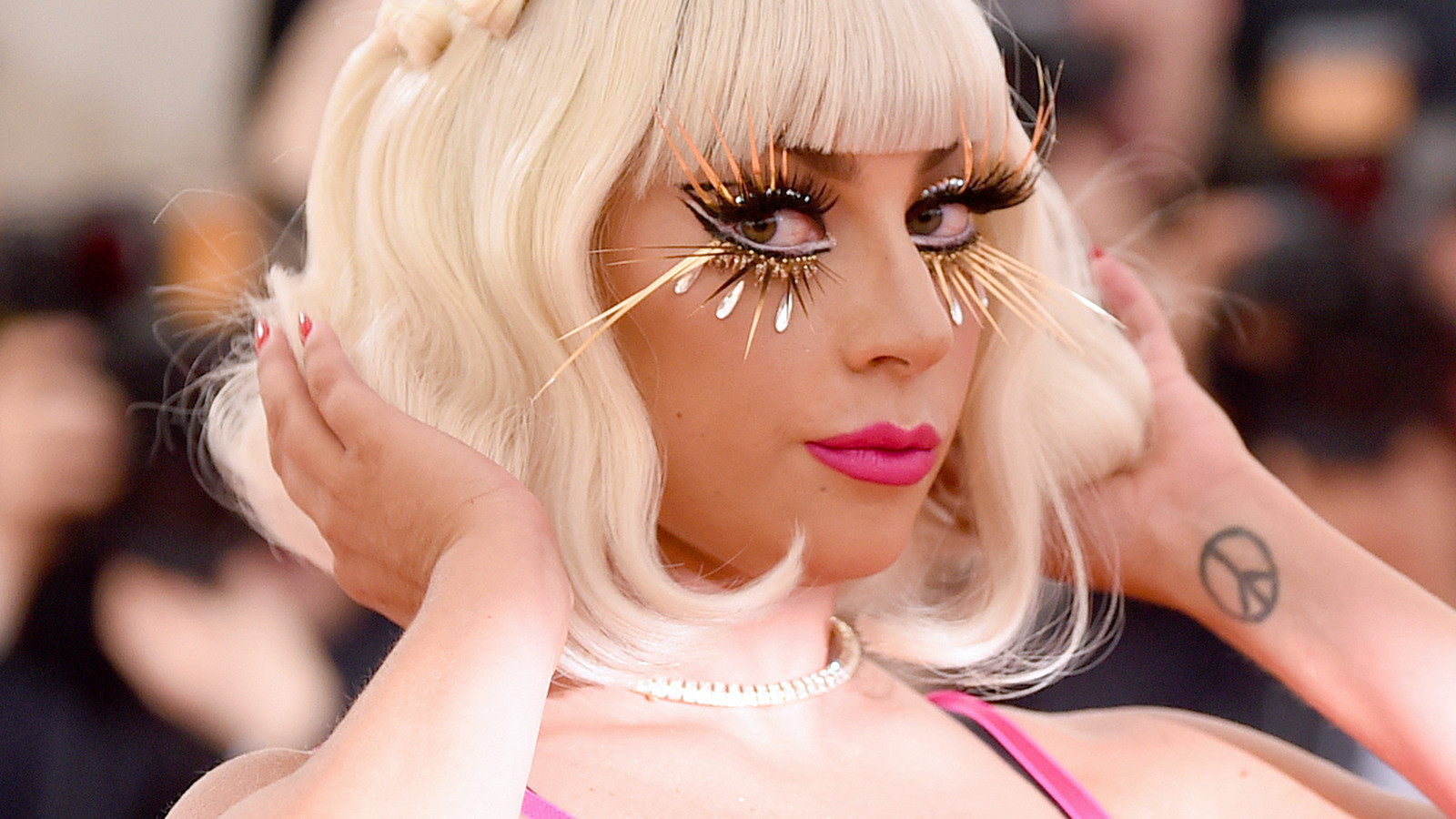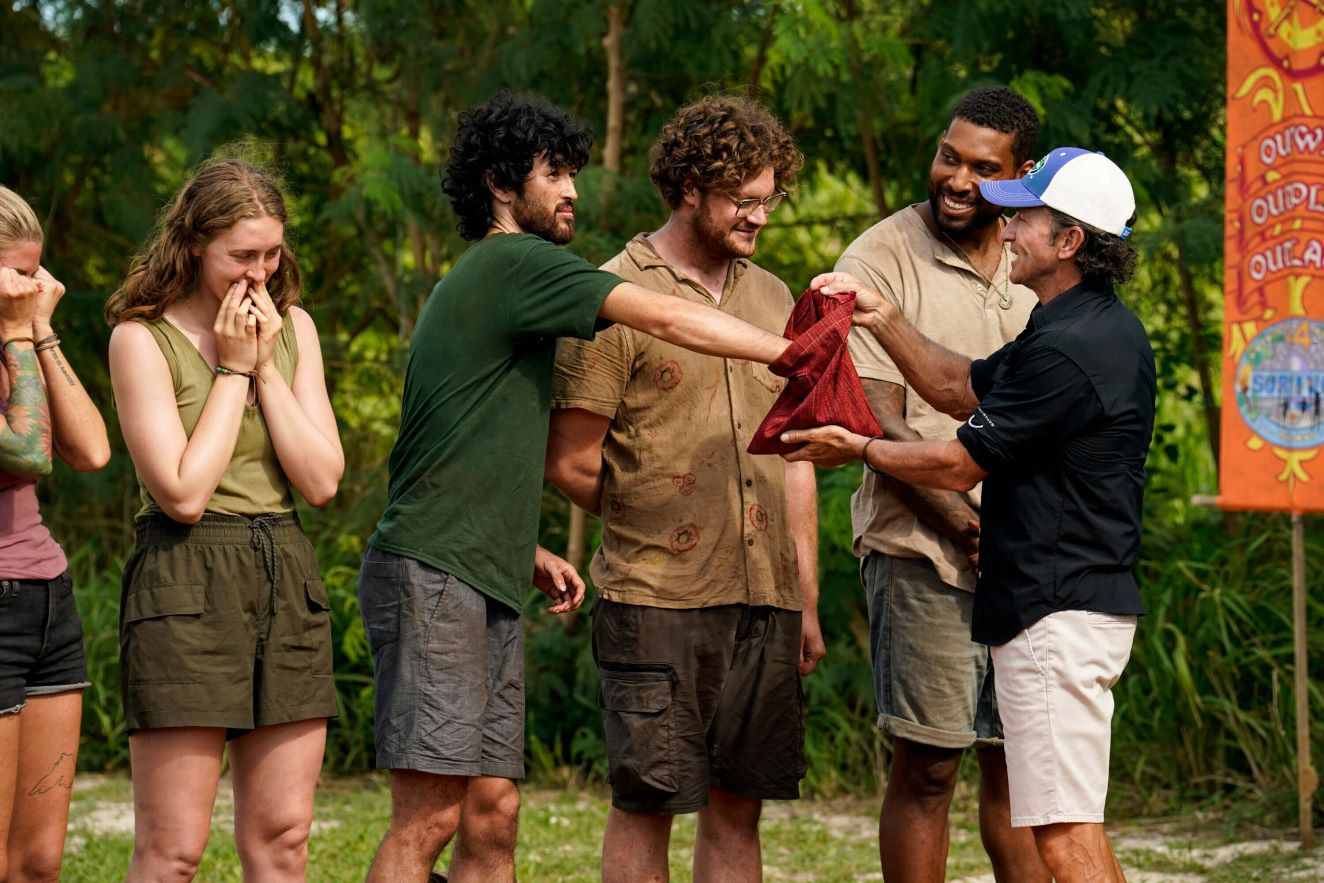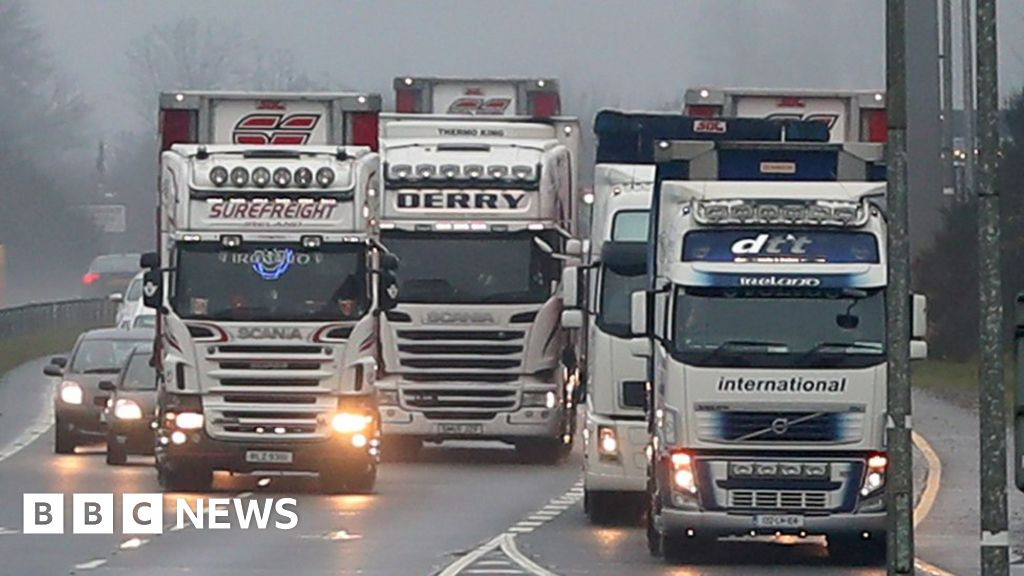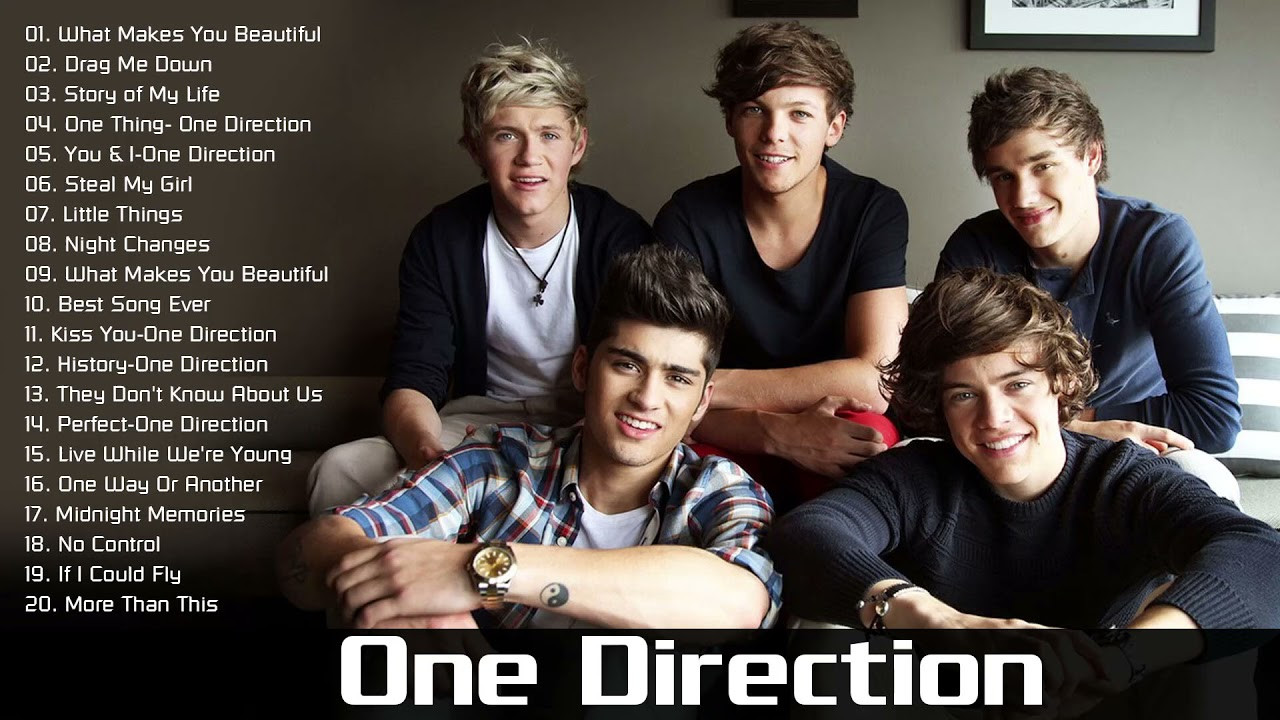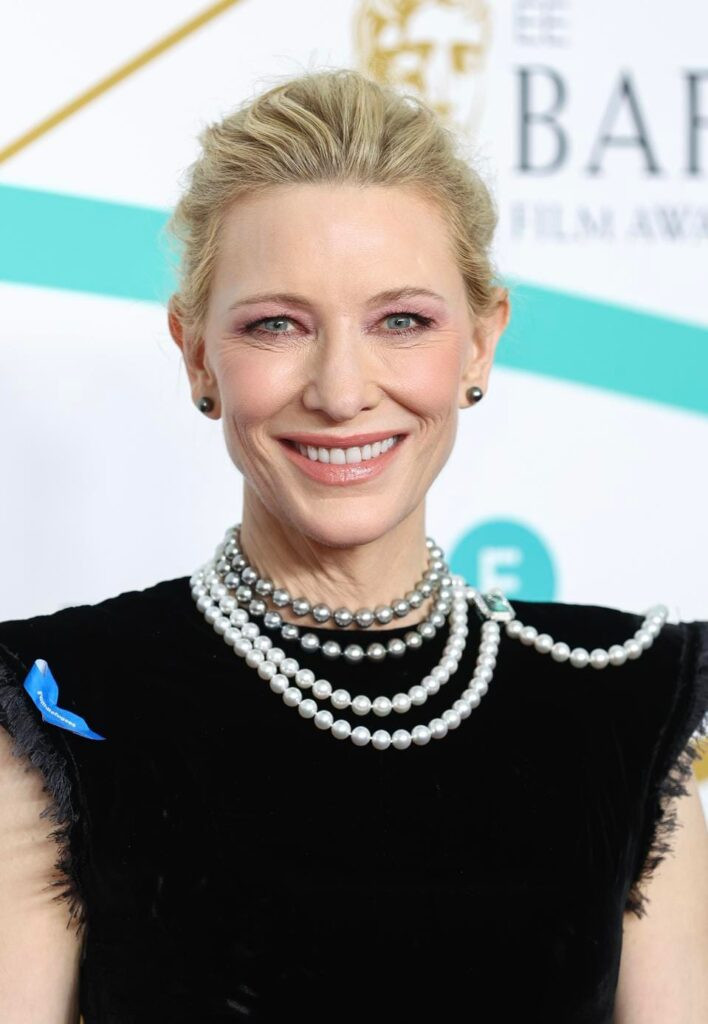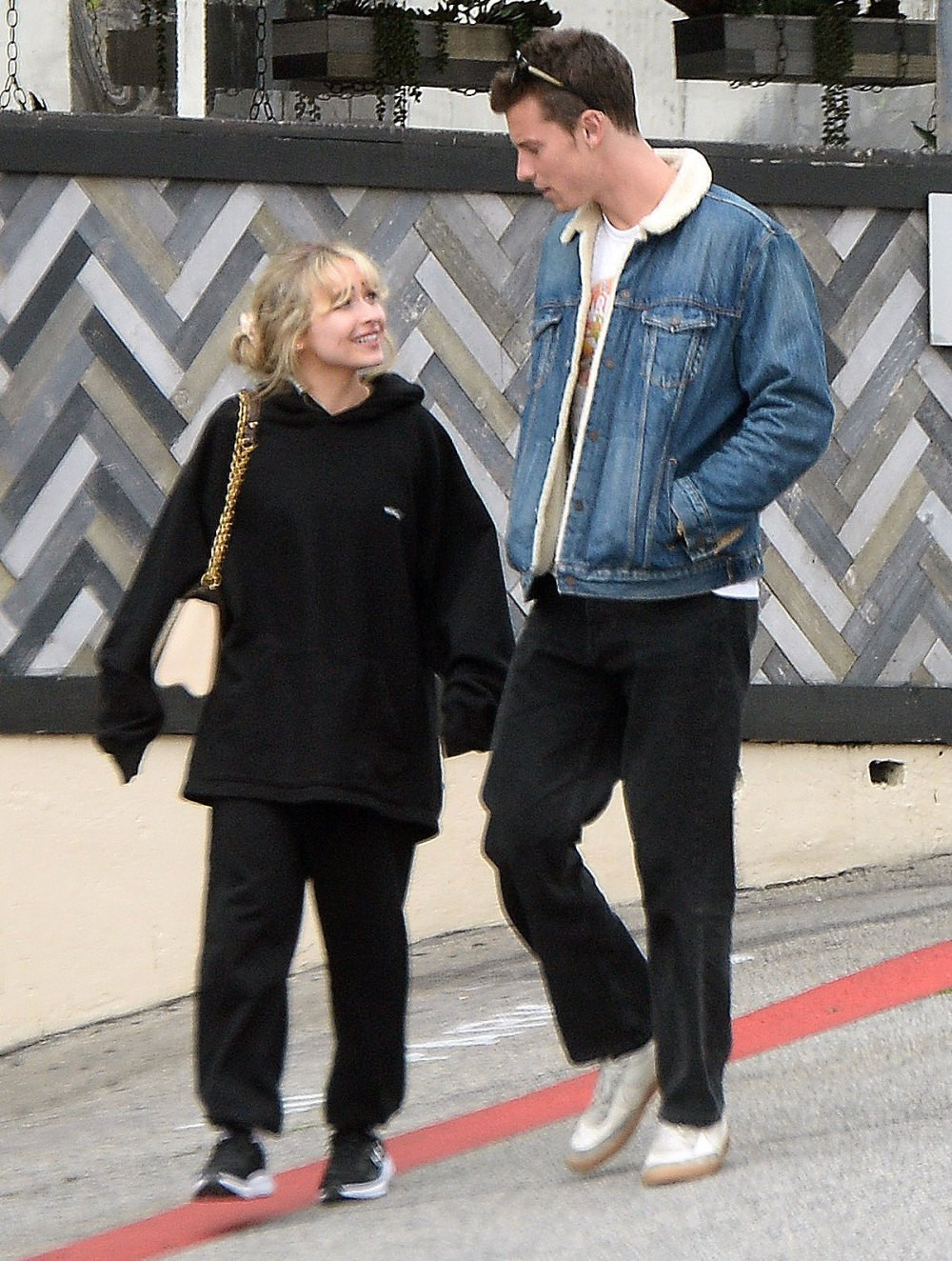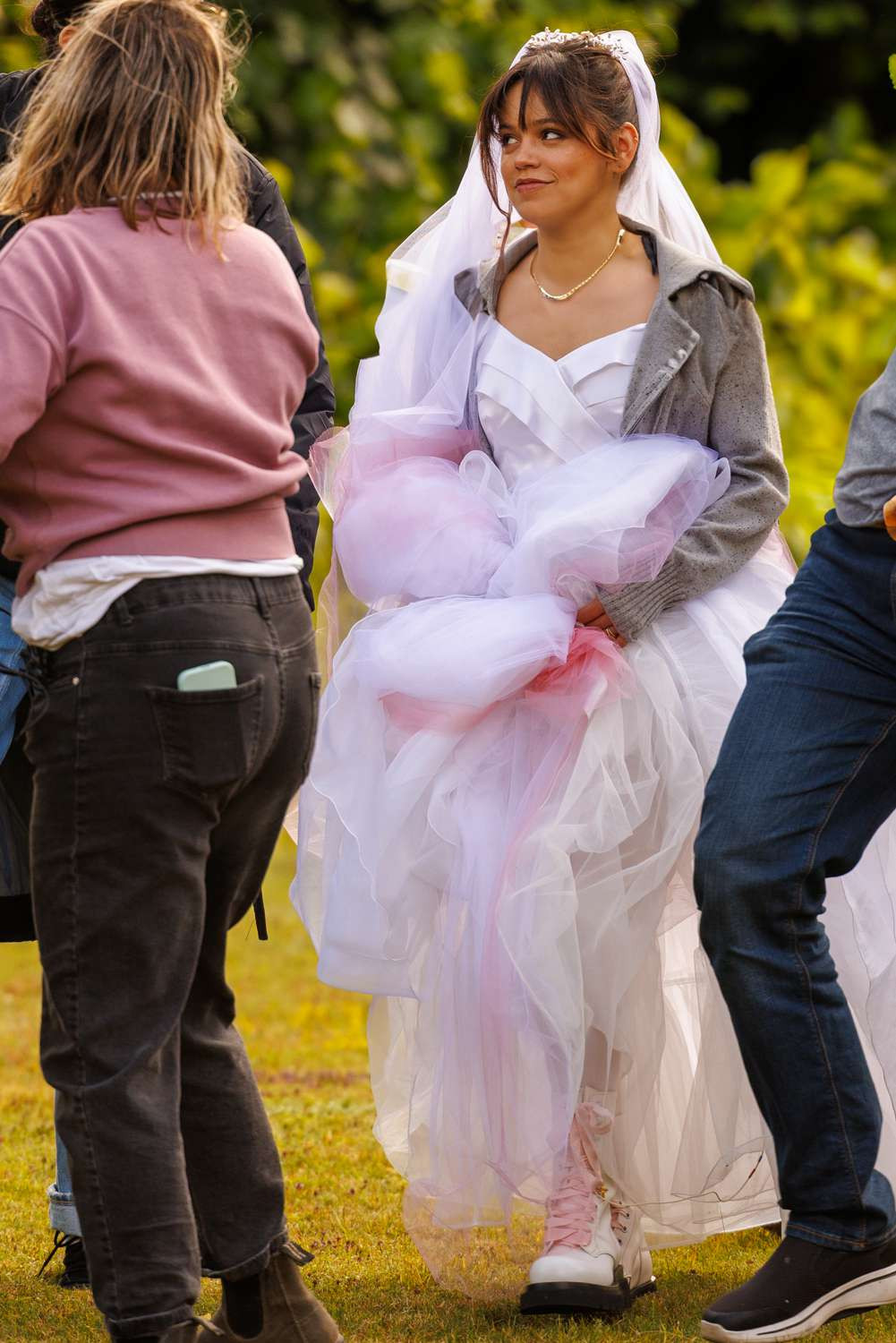The first four or five or six times I encountered Lady Gaga, in London or Paris or New York, backstage in Vegas or Madison Square Garden or the O2 arena, at the top of the Skytree in Tokyo or from inside a giant replica of her fragrance bottle at a party at the Guggenheim, or even when, six years ago, we hung out in her kitchen in Malibu and danced and cried while listening to music—“Like, real Italian style,” she said—every single one of those times, in all of those places, she was both there and not there. She was viscerally present and accounted for but also somehow absent. This is not a complaint.
Costumes have a way of upstaging people. You can get so hung up on all the finery and camouflage that you fail to see the person wearing it. A modern-day Marie Antoinette gown with a four-foot train, to take one example, doesn’t just change the way a person moves; it changes the way she behaves. “I don’t like the idea of you drinking wine out of a plastic cup,” Lady Gaga said to me one time in one such getup—a baroness proffering stemware as she minced toward me. The first time I laid eyes on her in December 2010, she was barefoot, covered in fake blood, mascara running down her face, wearing a robe made of voluminous red feathers—like a cross between Alice Cooper and Big Bird, I wrote. She was dressed like a lunatic and—you guessed it—behaving like one. On another occasion—in another astounding frock, hair in a Bride-of-Frankenstein updo—she had on shoes that made her feet look like they were screwed on backward and brought her up to nearly my height. To be clear: Gaga is tiny. But when I was still getting to know her she was acting like a woman who is six feet tall. To wit: She languidly draped her hand in mine so that I could examine her elaborately bejeweled dragon ring. “I’m going through an Elizabeth Taylor moment,” she said. “Don’t judge me.”
There are pictures from these adventures. One in particular, from Tokyo, speaks volumes. She is wearing the girliest little dress imaginable, though one made out of mirrored plastic cubes, that a fan left in front of her hotel room door. Was it the dress that made her behave like we were at prom? What you cannot see in the photos are the hundreds of Japanese photographers and cameramen grunting and jockeying for position, Gaga at the center of what felt like a circular firing squad. Once, in Paris, we went out for a very late lunch to which she wore a faded lavender ball gown that swept the floor and exposed her breasts. It had the effect of making it seem like she might, at any moment, collapse. Or maybe the dress demanded she inhabit a kind of helplessness—the Victorian woman in peril, the fainting damsel. There are paparazzi pictures of us coming and going from the restaurant. Her bodyguard, a very handsome bald man, is holding on to her arm (she’s so weak!), and I look like her bodyguard’s lesser twin, perhaps a doctor carrying smelling salts, escorting a madwoman to the sanatorium. A description Gaga would have no doubt loved at the time!
I don’t think I’ve ever spent more hours with someone over so many years and in so many different venues without ever getting a complete picture of who they really are. I was too swept up in the thrill of it all, the presentation of various personae, the interview as performance art. We talked for hours, and I never got the sense that she wasn’t being real with me. But I almost always flew home worried. There were a few too many unsavory people in the outer rings of the inner circle, there was too much chaos swirling around her. And then: the drinking and the smoking. It just made me a little nervous.
So when one day in July she walks into Shangri-La, the Malibu recording studio owned by Rick Rubin, looking like a woman who just pulled a sweater over her sweaty tights after a spin class, I am a little taken aback. The only trace of prior Lady Gaga iterations, at least today, are her eyebrows—bleached white, which lend her face the permanent cheerful surprise of a humanoid. Shangri-La, just a few minutes from her house, is actually a midcentury dwelling that somehow became a place where rock-and-roll superstars camped out to make music. (Bob Dylan’s tour bus from the ’70s is still parked in the backyard.) Gaga recorded her country-tinged 2016 album, Joanne, here, as well as some of the music from the soundtrack to her first major film, 2018’s A Star Is Born. In fact, the place has that energy, a kind of stripped-down, Pacific Coast Highway soft rock vibe but tightened up and modernized with white walls and painted floors. Gaga has spent the better part of 2024 here, recording both a surprise project and a new pop record she has taken to calling LG7, which comes out in February. (She will release its first single in October.) As we step past the baby grand, standing alone in its own glassed-in room, and out onto the lawn, where you can smell the briny Pacific just on the other side of the hedge, she says, “I’ve developed a relationship with this place—almost like a person.”
This is a classic Gaga trope, perceiving an object as human. Which reminds me of something: I had recently learned the word hyperobject, from a book by the philosopher and English professor Timothy Morton, which, to be grossly reductive, refers to things like global warming or Mexico: too complicated and too massively distributed to wrap your head around all at once. I explain this to her and add that I have begun to think of certain people as hyperobjects. Like you, I say. “Thank you,” she says, like a 10-year-old who has just received a gold star. I present that as a compliment, I say. “I receive that as a compliment,” she says.
We eventually find ourselves in a windowless room in front of a mixing board. As has often been the case, she wants to play me some new music. It is, after all, her primary way of communicating who she is—not just to her fans but also to herself. “There’s a lot of pain associated with this adventure,” she says, “and when I start to explore that pain it can bring out another side to my artistry. When I’m here at this studio, I’m relaxed and I am able to face my demons and what’s remarkable is…that’s the music. I’m able to hear it back.”
But I also think that playing music during interviews allows her to wind down the clock a bit. This is partly to do with the fact that she is not entirely comfortable doing interviews. She treats them with a kind of studied formality: make an entrance; have a bit of a walk around; let’s tend to these questions of yours and be done with it. When the interview is over, you know. Her body language changes, her voice goes into the upper register of ladylike politesse. Did you get what you needed?
She is given to saying things like, “I’m really excited for you—and my fans—to get to know me more for the texture of my heart.” This might sound mawkish or grandiose, but I know exactly what she means. And it comes up again and again—not just the idea that there are missing pieces of the Lady Gaga puzzle, but that she feels like we don’t actually know something fundamental about her because she has, by design, obscured herself behind masks. And one of the reasons why this conversation feels particularly relevant today is because her new film, Joker: Folie à Deux, is, at its core, a story about a fan, played by Lady Gaga. Her character, Lee, an enigma herself, seems only interested in Joaquin Phoenix’s character’s persona, Joker. Not so much the actual person behind the mask, the failed clown and stand-up comedian Arthur Fleck.
At one point, we get into a conversation about her own recent fanaticism. She rattles off a list: Charli XCX, Chappell Roan, Billie Eilish. “I mean, I really love them. I go on the internet and, like, cry. And I love Taylor Swift too. And Kesha. I watch it all, and I’m like: Yup. Go! Just Go.” Here, her voice cracks and her eyes well up with tears. “I’m not only cheering them on, I want them to know that my heart is in it with them. And I want them all to feel really happy.” I am strangely moved. “Sorry!” she shouts through a laugh as I hand her a tissue. I get it, I say. She stares at me for a second, blinks a couple of times, and says, “You and I getting together is really important.”
She pulls her legs up under herself and I notice that there is a sizable hole in the crotch of her gray leggings. “Being vulnerable is something that has changed, right?” she says. “Well, on the way over here I rushed home to change out of some of my gym clothes.” It is exactly one week before her performance at the opening ceremony of the Olympics in Paris and she has just come from rehearsal. “But I was on the phone with the guy who’s mixing my new project and I was giving him notes and then I noticed that there’s a hole in my pants, but I ran over here anyway because I didn’t want to be late. Back in the day, I would have felt a ton of pressure to be in full glam for you and be prepared to…perform.”
It’s as if she has been steadied; fixed in place; trued, in the carpentry sense—level. You seem different, I say. “I hope that’s good,” she says, cocking a bleached eyebrow. So, what’s changed? “The missing piece in my life was having real love,” she says. Did I mention the extra-sparkly diamond on her left hand? You can’t unsee it. It’s Wilma Flintstone–size, a cartoon diamond, but it suits her. She and Michael Polansky, her companion of nearly five years, got engaged in April after a day of rock climbing.
They met in 2019 through Gaga’s mother, Cynthia Germanotta, who runs the Born This Way Foundation, a nonprofit focused primarily on supporting young people’s mental health that Gaga and her mother set up in 2012. Cynthia met Polansky through philanthropic overlap; Polansky, who went to Harvard in the Zuckerberg era, is a longtime associate of Sean Parker, the cofounder of Napster and founding president of Facebook.
“My mom met him and she said to me, ‘I think I just met your husband,’ and I said, ‘I’m not ready to meet my husband!’ I could never have imagined that my mom…found the most perfect person for me?” Flash forward to December 2019: Parker’s 40th birthday party at his house in Los Angeles where Stevie Nicks performed. “I got invited and I said, ‘I wonder if Michael is going to be there,’ and my mom said yes, and so I went to the party and I kept asking for him and he finally came over to me and we talked for three hours. We had the most amazing conversation.” Polansky tells me that he didn’t make it three steps into the party before someone told him that Lady Gaga was looking for him. “I didn’t know much about her and honestly wasn’t sure what to expect,” he says. “I was struck immediately by her warmth and openness—she was so genuinely curious about what my life was like growing up in Minnesota.”
They talked on the phone for weeks, “and then we went on our first date,” says Gaga, “and just fell in love. And then COVID hit.” Polansky had been living in San Francisco, but during the pandemic they shacked up together at her Malibu house for well over a year. I remember seeing photos of the two of them in those eerie days in early 2020: Gaga and her scruffy new boyfriend in their soft pants, picking up a pizza and a bottle of wine—relatable content! “It was really kind of special,” she says. “I’d been so focused on my career since I was a teenager. And the gift of that time was that I got to completely focus on my relationship. I met this totally supportive, loving human being who wanted to get to know me—outside of Lady Gaga.”
“We had this amazing chapter of a weird kind of normalcy,” says Polansky, “that’s essential for any relationship to develop in a real way—taking walks, making coffee, hanging out with the dogs, reading books together….” He adds, “The pandemic was easier on her than you might think. She’s used to being isolated because of her fame and was able to take so much of it in stride. I think she loved the chance to slow down. She’s been operating at an unfathomable level of intensity for years and it’s no secret it had caught up to her.”
It is always awkward to talk about the upside of a pandemic. “It was very painful to see how deeply it affected the world,” she says. “Not only how sick people got, so many people died, but also so many people were alone. I feel very grateful that I wasn’t alone. I had never met anyone like Michael. He’s so smart and so kind. And his life and my life are very different. He’s a very private guy and he’s not with me for any other reason than that we are right for each other. But I think what I want my fans to know is that I’m just, like, so happy. I’m healthy. I feel like the last time they heard from me—in this way—was Chromatica, and that album was about an absolutely horrible time for me with my mental health. I was in a really dark place. I struggled for, like, many years before that. But everything started to change. Because I had a real friend who saw the ways in which I was unhappy and why. And he wasn’t afraid to truly hold my hand. And get to know me. On a very deep level.”
When Gaga talks about how they organize their lives, how they make decisions as a couple, their shared interests (“music, science, and art”), she uses the word family again and again. “Being on the same page is essential to keeping a family all together,” she says. It is no secret that she wants children. She’s said as much in interviews before—in 2013 (“at least three”) and then again, in 2020, when she was dating Polansky.
This is a far cry from how things looked 15 years ago. That December night in 2010, when Gaga was covered in fake blood and red feathers, she was bouncing off the walls, spilling drinks, and singing show tunes with a bunch of club kids backstage at the O2 arena. At one point, she stumbled up to me with her on-again-off-again boyfriend Lüc Carl. He was a manager of a Lower East Side bar, the “cool Nebraska guy” in her song “Yoü and I,” and the inspiration for many of the tracks on her first album, The Fame. “This is Lüc,” she said proudly. “He’s my boyfriend.” A smirk crossed his face. “Okay, Bette Midler,” he said. Sure, it was funny; but it was also cruel.
Lady Gaga has been engaged twice before: to actor Taylor Kinney in 2015, and to talent agent Christian Carino in 2018. She clearly has been looking for—and failing to find—the right guy. When I remind her of this she says, “I kind of thought I was going to have to do this all by myself—forever. And that was really scary. Because it’s a big life. And I don’t think anyone really knows what it feels like unless you’re in it.” Her voice drops into a softer tone. “And I don’t have to do this alone anymore.”
There is a scene in Joker: Folie à Deux in which Joaquin Phoenix’s character, Arthur Fleck—or perhaps Joker, it’s anybody’s guess—is doing a televised interview from prison, the goal of which is to improve public opinion ahead of his trial for murder. He insists that he has changed since the night when he blew a talk show host’s brains out on live television. What’s changed? asks the interviewer. “Well, I’ll tell you what’s changed,” says Arthur/Joker. “I’m not alone anymore.”
This is just one of the many uncanny echoes of not just my interview with Lady Gaga but of the absolutely bonkers nature of life these days. I saw the film less than 48 hours after watching an unhappy loner try to assassinate Donald Trump on live television. Failed clown attempts to murder talk show host could have almost been the headline on that bit of breaking news. It’s so close! All of which is to say that this very clever, wildly entertaining Joker sequel, anchored by touching performances, is perfectly calibrated for our times—which are so comically dark some days that no one would be even a little surprised if we all started to behave like lunatics loosed from the asylum. That is its vibe: a world gone mad. Let’s put on a show! The movie is essentially a courtroom drama, but then the characters also sing songs, mostly standards.
Gaga insists that it is not a musical. She recently learned the term meta-modern to describe certain films in which everything comes at you all at once. There is no differentiating thrillers from comedies from musicals; genres are melting into one another. Meta-modernism is a romantic impulse, a sincere reaction to darkness; or as the writer James MacDowell puts it, “ironic detachment with sincere engagement.” Bingo. That is what Folie à Deux gets at. Which also happens to be a perfectly fine description of Lady Gaga’s entire project.
There are other ways Lady Gaga fits nicely into the comic-tragic world that director Todd Phillips, screenwriter Scott Silver, and Joaquin Phoenix built for the 2019 blockbuster Joker, which grossed over $1 billion, the first R-rated movie to reach that benchmark. Both Joker films are loosely based on DC Comics characters, so we are in “Gotham City” in the early 1980s. But it can sometimes feel like we are also in the 1940s, particularly the scenes in so-called Arkham State Hospital, where the prison guards talk like Jimmy Cagney. You also catch whiffs of the modern world run amok, like in mid-’90s Los Angeles or early-2000s Manhattan when a mushroom cloud of debris from an explosion billows through downtown Gotham. And that is also very Gaga, a performer who can decade-switch like no other, paying homage to Julie Andrews on the Oscars telecast, touring with Tony Bennett, and then breathing new life into heavy metal, punk, and disco in any number of her original songs. Like her character in Joker, she has a timeless, unplaceable quality. And the musical moments in the film are perfectly suited to her: The standards are of the Sinatra/Garland variety, with a Burt Bacharach tune here, a Stevie Wonder song there. Who else could have pulled all of that off while also breaking your heart in tight close-up?
Todd Phillips was a producer on A Star Is Born, which is how he met Gaga. “She’s sort of touched, in a way,” he says. “She can be really hard on herself as a performer. She takes it seriously. But she’s magic, which sounds so simple, but that is actually the only way to describe her abilities.” When there was a script, Phillips sent it to Gaga’s agent, and before long Phillips was at Lady Gaga’s house in Malibu overlooking the Pacific drinking wine. A few weeks later, he returned with Joaquin Phoenix, whom Gaga had never met. “That was really kind of wonderful,” Phillips says. They hung out for hours, and, “as we were driving to dinner, Joaquin said, ‘We should invite her, don’t you think?’ And I was like, ‘Of course, but I don’t think she’s gonna come.’ You know, for some reason, Joaquin is just…a guy, but she’s Lady Gaga. So I called her and said, ‘Hey, we’re gonna go to Nobu, do you want to come?’ And she said, ‘Yeah, I’ll be five minutes behind you.’ She is the most uncomplicated-complicated person I’ve ever met. And that is her beauty as an artist, too.”
The lion’s share of the movie was filmed on the Warner Bros. lot in Burbank during the first three months of 2023. “We’d very often meet in Joaquin’s trailer and sometimes we would just tear the script up and start all over,” says Gaga. “It was a really cool, liberating process.” When I run this by Phillips he says, “My line about Joaquin is that he’s the tunnel at the end of the light.” He laughs. “You think, Okay, this scene works, let’s just go shoot it. And Joaquin’s like, ‘No, no, no, let’s just have a quick meeting about it,’ and it’s three hours later and you’re rewriting it on a napkin. What’s great about Lady Gaga is that she really holds her own both off camera when we’re in the trailer tearing things apart—which she probably spent the night before learning—but also on camera. It was not a small feat.”
Keep in mind: This is only Lady Gaga’s third leading role—and “the biggest movie I’ve ever been a part of,” she says. She is just six years into her movie-star era and yet it somehow feels like she’s been at it forever. “She puts herself around very powerful people,” says Phillips. “I mean, Bradley Cooper, to be across from him out of the gate. To be across from Adam Driver [in House of Gucci], who is a beast, and Joaquin who’s a beast. She’s in it—she went full in.”
And then, of course, she “brought” the music. “I wrote a waltz for the movie,” says Gaga. “And I had a live piano player, Alex Smith, whom I asked to be with me for my scenes. There are moments in the film where I’m playing an adult woman who sings like a little girl. And she’s moving through the world with this kind of immaturity, which I thought was interesting.” The images accompanying this story were partly inspired, Gaga says, “by the genius of Arianne Phillips”—Folie à Deux’s costume designer. “I had this vision: that my mom gave me my grandma’s dresses when I was a little girl and that they still fit me as an adult because I never really grew out of them. And my relationship with music in this film is like the way a child discovers music—as the ultimate form of happiness.”
There is one particularly affecting moment where Gaga as Lee is putting on Harley Quinn’s makeup in the mirror and singing “I’ve Got the World on a String” to herself, like any of us might when we’re alone—but better. The trick for Lady Gaga was learning how to sing like an ordinary citizen. “Yeah. I worked really hard on that, kind of trying to undo all my technique. I mean, Ally Maine in A Star Is Born is a singer and it’s a movie about people who make music,” she says. “That is not what this film is about at all.”
Phoenix, who sang most memorably as Johnny Cash in Walk the Line, says that Lady Gaga “encouraged me to sing live” in their scenes. “And I encouraged her to sing poorly. I remember asking her to sing without her vibrato. She has a beautiful vibrato—too beautiful. I think she felt naked without it. But as soon as she moved away from technique she unlocked her character’s voice.”
The film mucks around in fame and fans and mental illness and monsters—Lady Gaga themes, all. When I ask her how the film, or the character, relates to her own life, she surprises me with this eloquent bit of introspection: “Harley Quinn is a character people know from the ether of pop culture. I had a different experience creating her, namely my experience with mania and chaos inside—for me, it creates a quietness. Sometimes women are labeled as these overly emotional creatures and when we are overwhelmed we are erratic or unhinged. But I wonder if when things become so broken from reality, when we get pushed too far in life, what if it makes you…quiet?”
Her voice cracks again and she takes a moment. “I would say that I worked from a sense-memory perspective: What does it feel like to walk through the world and be…braced, in an intense way. And what happens when you cover up all of the complexities beneath the surface?”
She does eventually play music for me. One song, which was about to be released in a few weeks, is the sublime duet with Bruno Mars “Die With a Smile.” Gaga was in Malibu putting the final touches on her own record when Bruno called out of the blue. “He asked me to come to his studio to hear something,” says Gaga. “It was around midnight when I got there and I was blown away. We stayed up all night finishing the song.” She turns it all the way up. “Bruno and I think the world needs to hear this song,” she says. “It’s some real shit. It’s a real conversation. And it’s about love.”
She queues up a song from her new pop record. It’s intense and ominous—an old-school Gaga banger, unsettling but also buoyant. She does not want to say too much about the new record other than to tell me that it was her fiancé’s idea. “Michael is the person who told me to make a new pop record. He was like, ‘Babe. I love you. You need to make pop music.’ ” Says Polansky: “Like anyone would do for the person they love, I encouraged her to lean in to the joy of it. On the Chromatica tour, I saw a fire in her; I wanted to help her keep that alive all the time and just start making music that made her happy.”
Chromatica, Gaga’s last pop album, came out in May 2020, right after the world locked down and “Stupid Love” and “Rain on Me” became the soundtrack to that terrible moment. “When I went on the Chromatica Ball tour in 2022,” she says, “that was the first time I’ve performed not in pain in…I don’t even remember.”
Lady Gaga fractured her hip during her Born This Way Ball tour a decade before, which set in motion years of pain from fibromyalgia, a chronic disorder that manifests as widespread muscle pain, her agony documented in the 2017 Netflix film Gaga: Five Foot Two.
The Chromatica tour was an epiphany. “Michael and I did that tour together,” she says. “I did it pain-free! I haven’t smoked pot in years. I’ve, like, changed.” She laughs. “A lot. I feel like this new album, in a lot of ways, is about that time but from a place of happiness instead of misery. And now, Michael and I are really excited to organize our lives—and our marriage—around our creative output as a couple.” She shoots me a look. “Which is really different than, like, doing what other people want you to do.”
By other people she means the music industry—the whole management, record label, touring infrastructure that she’s been living with for nearly 20 years. “For a long time, for most of my career,” she says, “my life was controlled by this business: what people wanted from me; what they hoped I could achieve; how to keep me going. And that can be a lot of pressure and it’s scary. But I feel like I’m finally coming out on the other side.”
I had always assumed it was she who was at the helm, steering the ship. Who else if not Lady Gaga? “When it comes to my artistry, that is true,” she says. “I signed my first deal when I was 19. And I wouldn’t say I marched into my career knowing how to navigate the business of it all. I think a lot of pop stars get really overwhelmed by this industry. And sometimes we don’t make it into our 30s.” A quick look of self-satisfaction: “I’ve already made it pretty far.”
Don’t call me Gaga. That is the opening line of the song “Monster” on Lady Gaga’s 2009 EP, The Fame Monster. Every time I hear it I laugh because that is exactly what I call her: Gaga. I don’t know her well enough to call her Stefani. Never. I bring this up because it’s a question that is hovering over this interview, partly because of all this Joker talk: Is it all fantasy? Is Lady Gaga…a persona?
“Man.” She shakes her head. “That’s a big question.” She takes a deep breath. “You know it’s not a persona. It’s not. I am all of these things. The person that I am when I’m onstage in front of 85,000 people? That is also me. That’s like one of the freedoms of my relationship with Michael. It feels really nice to have someone value you whether there’s 85,000 people watching or…the dogs. To see the whole you. And Lady Gaga is the whole me.
“There was a time in my career when I…. Look….”—she cocks an eyebrow and slips into a self mocking tone—“where I spoke in an accent in interviews or told lies, but I was performing. Now, it’s a much more palatable mixture of authenticity and imagination. I feel like the world, to a fault, operates in these binaries: You’re either real or you’re fake; you’re authentic or you’re shallow. But for me, I played a lot with artifice. I was fascinated with artifice, really, truly fascinated with it as an artistic tool. I still am. But my relationship to myself as an artist now is more empowered: This is me. This. Is. Me. It’s too…complicated to split yourself in two and have to turn it off and on. It’s so much more empowering to be like, I’m a woman and I’m super complex. Michael said to me once, ‘I will know that you’re really feeling great when you know that you have you.’ I used to always be like, But who’s gonna have my back?! And now I’m like, I’ve got my back.”




